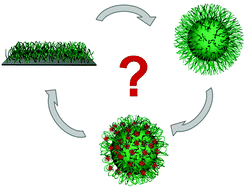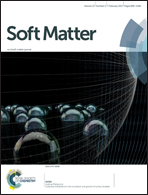Controlled and tunable design of polymer interface for immobilization of enzymes: does curvature matter?†
Abstract
Control and tuning of surface properties is indispensable for the programmed and rational design of materials. Particularly, polymeric brush-modified colloids can be used as carrier materials for enzyme immobilization. Although it is of prime importance to control the brush architecture, there is still a lack of systematic investigations concerning the impact of grafting density on the properties of the designed interface, as well as on the immobilization of biomolecules. In this work, we investigate the surface properties of polymer brushes with different grafting densities prepared using a “grafting from” approach on flat and on colloidal particle substrates by varying the density of initiator groups. In this way, we control and tune interfacial properties of the carrier material such as swelling, charge, adhesion as well as adsorption of laccase from Trametes versicolor on the grafted polyelectrolyte layer. We show that there is no direct transferability of the results received from planar to curved substrates regarding the swelling behavior in dependence on the grafting density. The maximum of swelling degree of PDMAEMA layers is achieved at 0.34 nm−2 and at 0.1 nm−2 grafting density for planar and curved particle substrates, respectively. The adhesion properties of the polymeric layer on both substrates are also strongly influenced by the grafting density, i.e. a decrease of the grafting density causes a transition from the adhesive to non-adhesive state. As proven by the cryo-TEM and AFM force distance measurements, an immobilization of laccase from Trametes versicolor causes a decrease of the polymer swelling and therefore leads to the changes in the surface morphology, charge and adhesion performance of final polymer–enzyme layer. Moreover, the higher effectiveness and activity of laccase were observed for the intermediate grafting densities which seem to be preferable over the maximum brush densities.

- This article is part of the themed collection: Soft Matter at Aqueous Interfaces


 Please wait while we load your content...
Please wait while we load your content...